痔临床诊治指南(2006版)
- 格式:pdf
- 大小:310.56 KB
- 文档页数:4
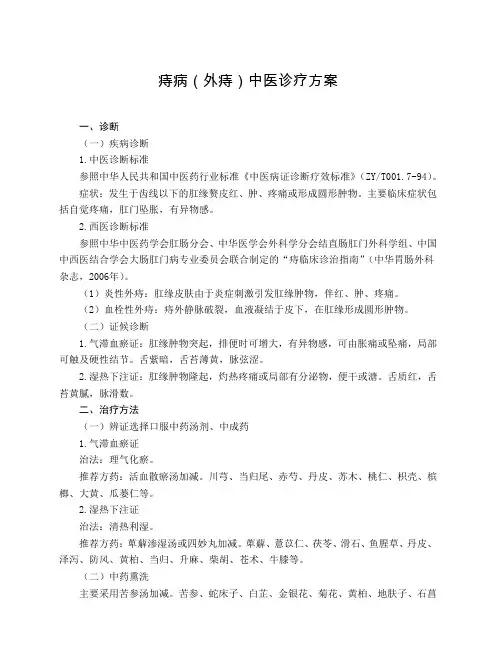
痔病(外痔)中医诊疗方案一、诊断(一)疾病诊断1.中医诊断标准参照中华人民共和国中医药行业标准《中医病证诊断疗效标准》(ZY/T001.7-94)。
症状:发生于齿线以下的肛缘赘皮红、肿、疼痛或形成圆形肿物。
主要临床症状包括自觉疼痛,肛门坠胀,有异物感。
2.西医诊断标准参照中华中医药学会肛肠分会、中华医学会外科学分会结直肠肛门外科学组、中国中西医结合学会大肠肛门病专业委员会联合制定的“痔临床诊治指南”(中华胃肠外科杂志,2006年)。
(1)炎性外痔:肛缘皮肤由于炎症刺激引发肛缘肿物,伴红、肿、疼痛。
(2)血栓性外痔:痔外静脉破裂,血液凝结于皮下,在肛缘形成圆形肿物。
(二)证候诊断1.气滞血瘀证:肛缘肿物突起,排便时可增大,有异物感,可由胀痛或坠痛,局部可触及硬性结节。
舌紫暗,舌苔薄黄,脉弦涩。
2.湿热下注证:肛缘肿物隆起,灼热疼痛或局部有分泌物,便干或溏。
舌质红,舌苔黄腻,脉滑数。
二、治疗方法(一)辨证选择口服中药汤剂、中成药1.气滞血瘀证治法:理气化瘀。
推荐方药:活血散瘀汤加减。
川芎、当归尾、赤芍、丹皮、苏木、桃仁、枳壳、槟榔、大黄、瓜蒌仁等。
2.湿热下注证治法:清热利湿。
推荐方药:萆薢渗湿汤或四妙丸加减。
萆薢、薏苡仁、茯苓、滑石、鱼腥草、丹皮、泽泻、防风、黄柏、当归、升麻、柴胡、苍术、牛膝等。
(二)中药熏洗主要采用苦参汤加减。
苦参、蛇床子、白芷、金银花、菊花、黄柏、地肤子、石菖蒲、忍冬藤等煎水,每日2次,7次为一疗程。
操作方法:熏洗前应先揭去敷料、排空二便。
熏洗温度40~45℃为宜,熏洗时间为5分钟/次。
年老体弱者应有家属或护工陪护,水温不宜过高,以免烫伤。
每天2次,7天为一疗程。
在熏洗期间护理人员应询问病人的自我感觉,并观察创面及周围皮肤情况。
如有皮疹、湿疹、皮肤瘙痒时,应采取相应的措施。
(三)中药外敷可选用马应龙麝香痔疮膏、肛泰软膏、九华膏等。
外涂于患处,每天2次,7天为1个疗程。
(四)健康指导1.注意休息,避免久坐,不要挤压。
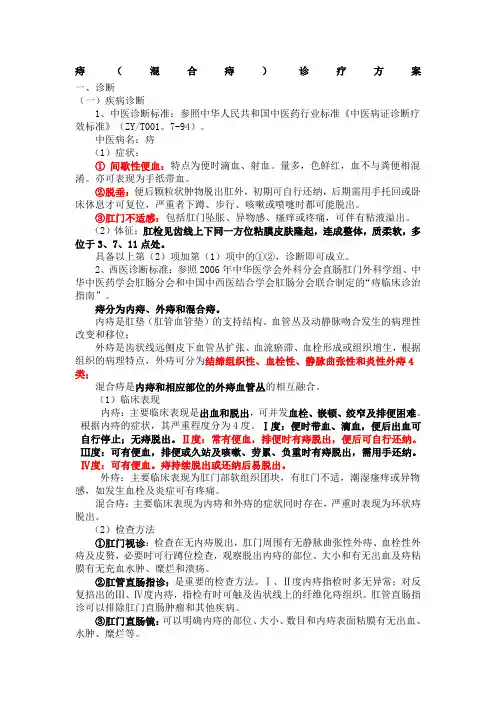
痔(混合痔)诊疗方案一、诊断(一)疾病诊断1、中医诊断标准:参照中华人民共和国中医药行业标准《中医病证诊断疗效标准》(ZY/T001。
7-94)。
中医病名:痔(1)症状:①间歇性便血:特点为便时滴血、射血。
量多,色鲜红,血不与粪便相混淆。
亦可表现为手纸带血。
②脱垂:便后颗粒状肿物脱出肛外,初期可自行还纳,后期需用手托回或卧床休息才可复位,严重者下蹲、步行、咳嗽或喷嚏时都可能脱出。
③肛门不适感:包括肛门坠胀、异物感、瘙痒或疼痛,可伴有粘液溢出。
(2)体征:肛检见齿线上下同一方位粘膜皮肤隆起,连成整体,质柔软,多位于3、7、11点处。
具备以上第(2)项加第(1)项中的①②,诊断即可成立。
2、西医诊断标准:参照2006年中华医学会外科分会直肠肛门外科学组、中华中医药学会肛肠分会和中国中西医结合学会肛肠分会联合制定的“痔临床诊治指南”。
痔分为内痔、外痔和混合痔。
内痔是肛垫(肛管血管垫)的支持结构、血管丛及动静脉吻合发生的病理性改变和移位;外痔是齿状线远侧皮下血管丛扩张、血流瘀滞、血栓形成或组织增生,根据组织的病理特点,外痔可分为结缔组织性、血栓性、静脉曲张性和炎性外痔4类;混合痔是内痔和相应部位的外痔血管丛的相互融合。
(1)临床表现内痔:主要临床表现是出血和脱出,可并发血栓、嵌顿、绞窄及排便困难。
根据内痔的症状,其严重程度分为4度。
Ⅰ度:便时带血、滴血,便后出血可自行停止;无痔脱出。
Ⅱ度:常有便血,排便时有痔脱出,便后可自行还纳。
Ⅲ度:可有便血,排便或久站及咳嗽、劳累、负重时有痔脱出,需用手还纳。
Ⅳ度:可有便血。
痔持续脱出或还纳后易脱出。
外痔:主要临床表现为肛门部软组织团块,有肛门不适,潮湿瘙痒或异物感,如发生血栓及炎症可有疼痛。
混合痔:主要临床表现为内痔和外痔的症状同时存在,严重时表现为环状痔脱出。
(2)检查方法①肛门视诊:检查在无内痔脱出,肛门周围有无静脉曲张性外痔、血栓性外痔及皮赘,必要时可行蹲位检查,观察脱出内痔的部位、大小和有无出血及痔粘膜有无充血水肿、糜烂和溃疡。

痔(痔病)一、诊断(一)中医病名:痔(二)疾病诊断1. 中医诊断标准【参照中华人民共和国中医药行业标准《中医病证诊断疗效标准》(ZY/T001.1-94))】痔系发生于齿线以上、下的静脉曲张团块。
(1)辩病依据①便血,色鲜红。
②肛门肿物脱出肛外,便后自行或手法复位。
③排便或增加腹压时,肛内肿物脱出,不能自行复位,需休息后或手法复位,甚者可发生嵌顿,伴有剧烈疼痛。
肛门镜检查:齿线上方有粘膜隆起,表面暗红,或纤维化。
④肛缘皮肤损伤或感染,呈红肿或破溃成脓,疼痛明显。
多见于炎性外痔。
⑤肛缘皮下突发青紫色肿块,局部皮肤水肿,肿块初起尚软,疼痛剧烈,渐变硬,可活动,触痛明显。
多见于血栓性外痔。
⑥排便时或久蹲,肛缘皮有柔软青紫色团块隆起(静脉曲张团),可伴有坠胀感,团块按压后可消失。
多见于静脉曲张性外痔。
⑦肛缘皮赘突起。
多见于结缔组织外痔。
⑧可有肛门坠胀、异物感或疼痛。
⑨可伴有局部分泌物或瘙痒。
⑩肛管内齿线上下同一方位出现肿物(齿线下亦可为赘皮)。
凡符合上述表现之一者即可诊断为“痔”。
(2)证候分类①风伤肠络:大便带血、滴血或喷射状出血,血色鲜红,或有肛门瘙痒。
舌红,苔薄白或薄黄,脉浮数。
②湿热下注:便血色鲜,量较多,肛内肿物外脱,可自行回缩,肛门灼热。
舌红,苔黄腻,脉滑数。
③气滞血瘀:肛内肿物脱出,甚或嵌顿,肛管紧缩,坠胀疼痛。
甚则肛缘有血栓,水肿,触痛明显。
舌质暗红,苔白或黄,脉弦细涩。
④脾虚气陷:肛门坠胀,肛内肿物外脱,需手法复位。
便血色鲜或淡,可出现贫血,面色少华,头昏神疲,少气懒言,纳少便溏。
舌淡胖,边有齿痕,舌苔薄白,脉弱。
2. 西医诊断标准【参照2006年中华医学会外科分会结直肠肛门外科学组、中华中医药学会肛肠分会和中国中西医结合学会肛肠分会联合制定的“痔临床诊治指南”。
】内痔:位于齿线上方,是肛垫(肛管血管垫)的支持结构、血管丛及动静脉吻合发生的病理性改变和移位,表面为直肠粘膜所覆盖,常见于左侧、右前和右后位。
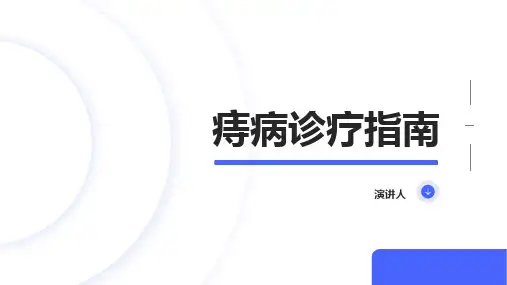
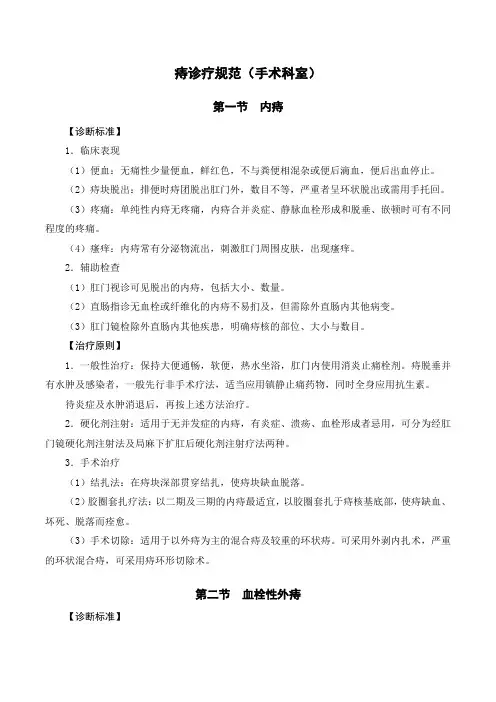
痔诊疗规范(手术科室)第一节内痔【诊断标准】1.临床表现(1)便血:无痛性少量便血,鲜红色,不与粪便相混杂或便后滴血,便后出血停止。
(2)痔块脱出:排便时痔团脱出肛门外,数目不等,严重者呈环状脱出或需用手托回。
(3)疼痛:单纯性内痔无疼痛,内痔合并炎症、静脉血栓形成和脱垂、嵌顿时可有不同程度的疼痛。
(4)瘙痒:内痔常有分泌物流出,刺激肛门周围皮肤,出现瘙痒。
2.辅助检查(1)肛门视诊可见脱出的内痔,包括大小、数量。
(2)直肠指诊无血栓或纤维化的内痔不易扪及,但需除外直肠内其他病变。
(3)肛门镜检除外直肠内其他疾患,明确痔核的部位、大小与数目。
【治疗原则】1.一般性治疗:保持大便通畅,软便,热水坐浴,肛门内使用消炎止痛栓剂。
痔脱垂并有水肿及感染者,一般先行非手术疗法,适当应用镇静止痛药物,同时全身应用抗生素。
待炎症及水肿消退后,再按上述方法治疗。
2.硬化剂注射:适用于无并发症的内痔,有炎症、溃疡、血栓形成者忌用,可分为经肛门镜硬化剂注射法及局麻下扩肛后硬化剂注射疗法两种。
3.手术治疗(1)结扎法:在痔块深部贯穿结扎,使痔块缺血脱落。
(2)胶圈套扎疗法:以二期及三期的内痔最适宜,以胶圈套扎于痔核基底部,使痔缺血、坏死、脱落而痊愈。
(3)手术切除:适用于以外痔为主的混合痔及较重的环状痔。
可采用外剥内扎术,严重的环状混合痔,可采用痔环形切除术。
第二节血栓性外痔【诊断标准】1.临床表现(1)肿块:肛门周围突发暗紫色卵圆形肿块。
(2)疼痛:局部疼痛是血栓性外痔的特点,活动与排便时加剧。
2.辅助检查(1)肛门视诊:肛门部一卵圆形暗紫红色有一定张力之包块。
(2)肛门指诊:肛门周围质硬性肿块,触之压痛明显。
【治疗原则】1.急性期(1~3天之内):在局麻下切开,取血栓减压,而后每日换药并坐浴(高锰酸钾液)。
2.较轻或非急性期:以热敷、热水坐浴为主。
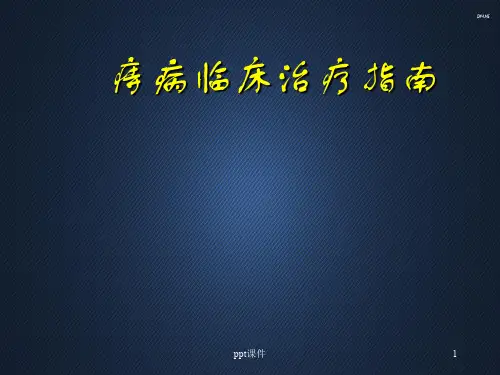
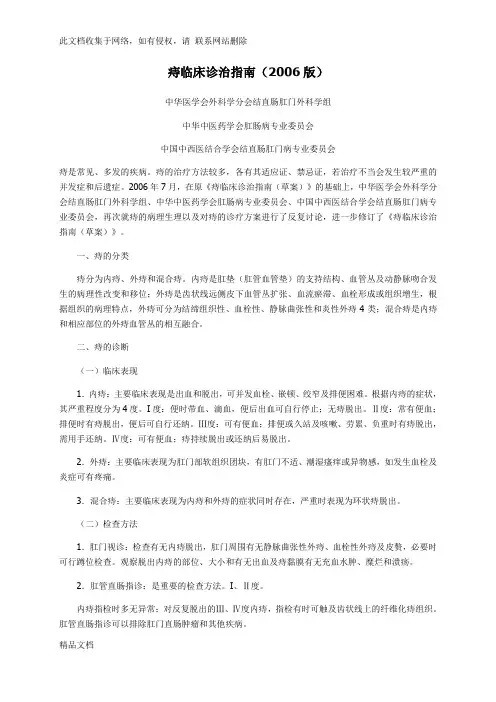
痔临床诊治指南(2006版)中华医学会外科学分会结直肠肛门外科学组中华中医药学会肛肠病专业委员会中国中西医结合学会结直肠肛门病专业委员会痔是常见、多发的疾病。
痔的治疗方法较多,各有其适应证、禁忌证,若治疗不当会发生较严重的并发症和后遗症。
2006年7月,在原《痔临床诊治指南(草案)》的基础上,中华医学会外科学分会结直肠肛门外科学组、中华中医药学会肛肠病专业委员会、中国中西医结合学会结直肠肛门病专业委员会,再次就痔的病理生理以及对痔的诊疗方案进行了反复讨论,进一步修订了《痔临床诊治指南(草案)》。
一、痔的分类痔分为内痔、外痔和混合痔。
内痔是肛垫(肛管血管垫)的支持结构、血管丛及动静脉吻合发生的病理性改变和移位;外痔是齿状线远侧皮下血管丛扩张、血流瘀滞、血栓形成或组织增生,根据组织的病理特点,外痔可分为结缔组织性、血栓性、静脉曲张性和炎性外痔4类;混合痔是内痔和相应部位的外痔血管丛的相互融合。
二、痔的诊断(一)临床表现1.内痔:主要临床表现是出血和脱出,可并发血栓、嵌顿、绞窄及排便困难。
根据内痔的症状,其严重程度分为4度。
I度:便时带血、滴血,便后出血可自行停止;无痔脱出。
Ⅱ度:常有便血;排便时有痔脱出,便后可自行还纳。
Ⅲ度:可有便血;排便或久站及咳嗽、劳累、负重时有痔脱出,需用手还纳。
Ⅳ度:可有便血;痔持续脱出或还纳后易脱出。
2.外痔:主要临床表现为肛门部软组织团块,有肛门不适、潮湿瘙痒或异物感,如发生血栓及炎症可有疼痛。
3.混合痔:主要临床表现为内痔和外痔的症状同时存在,严重时表现为环状痔脱出。
(二)检查方法1.肛门视诊:检查有无内痔脱出,肛门周围有无静脉曲张性外痔、血栓性外痔及皮赘,必要时可行蹲位检查。
观察脱出内痔的部位、大小和有无出血及痔黏膜有无充血水肿、糜烂和溃疡。
2.肛管直肠指诊:是重要的检查方法。
I、Ⅱ度。
内痔指检时多无异常;对反复脱出的Ⅲ、Ⅳ度内痔,指检有时可触及齿状线上的纤维化痔组织。
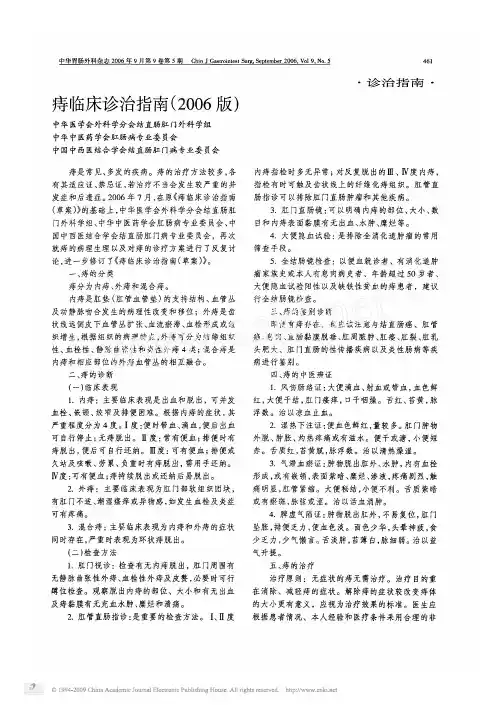
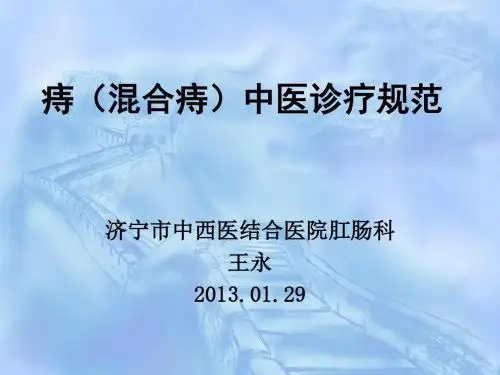
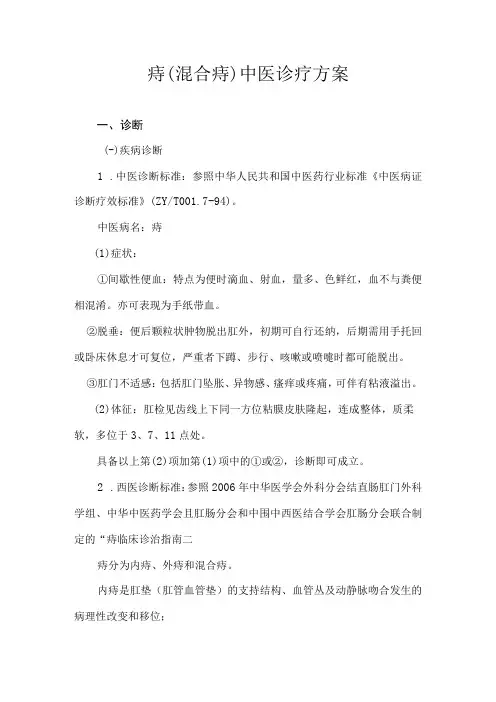
痔(混合痔)中医诊疗方案一、诊断(-)疾病诊断1.中医诊断标准:参照中华人民共和国中医药行业标准《中医病证诊断疗效标准》(ZY/T001.7-94)。
中医病名:痔(1)症状:①间歇性便血:特点为便时滴血、射血,量多、色鲜红,血不与粪便相混淆。
亦可表现为手纸带血。
②脱垂:便后颗粒状肿物脱出肛外,初期可自行还纳,后期需用手托回或卧床休息才可复位,严重者下蹲、步行、咳嗽或喷嚏时都可能脱出。
③肛门不适感:包括肛门坠胀、异物感、瘙痒或疼痛,可伴有粘液溢出。
(2)体征:肛检见齿线上下同一方位粘膜皮肤隆起,连成整体,质柔软,多位于3、7、11点处。
具备以上第(2)项加第(1)项中的①或②,诊断即可成立。
2.西医诊断标准:参照2006年中华医学会外科分会结直肠肛门外科学组、中华中医药学会且肛肠分会和中围中西医结合学会肛肠分会联合制定的“痔临床诊治指南二痔分为内痔、外痔和混合痔。
内痔是肛垫(肛管血管垫)的支持结构、血管丛及动静脉吻合发生的病理性改变和移位;外痔是齿状线远侧皮下血管丛扩张、血流瘀滞、血栓形成或组织增生,根据组织的病理特点,外痔可分为结缔组织性、血栓性、静脉曲张性和炎性外痔4类;混合痔是内痔和相应部位的外痔血管丛的相互融合。
(1)临床表现内痔:主要临床表现是出血和脱出,可并发血栓、嵌顿、绞窄及排便困难。
根据内痔的症状,其严重程度分为4度。
I度:便时带血、滴血,便后出血可自行停止;无痔脱出。
∏度:常有便血;排便时有痔脱出,便后可自行还纳。
In度:可有便血;排便或久站及咳嗽、劳累、负重时有痔脱出,需用手还纳。
IV度:可有便血;痔持续脱出或还纳后易脱出。
外痔:主要临床表现为肛门部软组织团块,有肛门不适、潮湿瘙痒或异物感,如发生血栓及炎症可有疼痛。
混合痔:主要临床表现为内痔和外痔的症状同时存在,严重时表现为环状痔脱出。
(2)检查方法①肛门视诊:检查有无内痔脱出,肛门周围有无静脉曲张性外痔、血栓性外痔及皮赘,必要时可行蹲位检查。
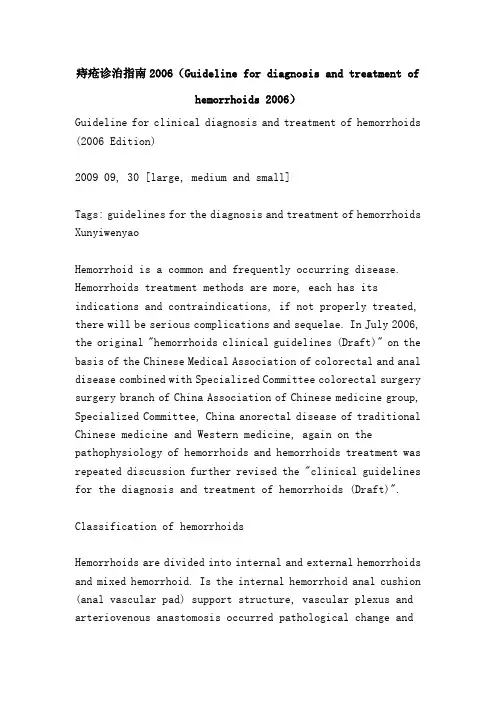
痔疮诊治指南2006(Guideline for diagnosis and treatment ofhemorrhoids 2006)Guideline for clinical diagnosis and treatment of hemorrhoids (2006 Edition)2009 09, 30 [large, medium and small]Tags: guidelines for the diagnosis and treatment of hemorrhoids XunyiwenyaoHemorrhoid is a common and frequently occurring disease. Hemorrhoids treatment methods are more, each has its indications and contraindications, if not properly treated, there will be serious complications and sequelae. In July 2006, the original "hemorrhoids clinical guidelines (Draft)" on the basis of the Chinese Medical Association of colorectal and anal disease combined with Specialized Committee colorectal surgery surgery branch of China Association of Chinese medicine group, Specialized Committee, China anorectal disease of traditional Chinese medicine and Western medicine, again on the pathophysiology of hemorrhoids and hemorrhoids treatment was repeated discussion further revised the "clinical guidelines for the diagnosis and treatment of hemorrhoids (Draft)".Classification of hemorrhoidsHemorrhoids are divided into internal and external hemorrhoids and mixed hemorrhoid. Is the internal hemorrhoid anal cushion (anal vascular pad) support structure, vascular plexus and arteriovenous anastomosis occurred pathological change andshift; external is the dentate line distal subcutaneous vascular plexus expansion, blood stasis, thrombosis or tissue hyperplasia, according to the pathological characteristics of tissue, external hemorrhoids can be divided into connective tissue, and thrombotic varicose veins and inflammatory external hemorrhoids 4; mixed hemorrhoids external hemorrhoids and hemorrhoids is the integration of the corresponding parts of the vascular plexus.Two 、 diagnosis of hemorrhoids(I) clinical manifestation1.: the main clinical manifestations of hemorrhoids bleeding and prolapse, complicated by thrombosis, incarceration, strangulation and bowel problems. According to the severity of symptoms of hemorrhoids, divided into 4 degrees. I degrees: when taking blood and blood drop, then the bleeding can stop by itself; no hemorrhoid prolapse. II: often have hematochezia; defecation have prolapse, after can also satisfied. Third degree: can have hematochezia; defecation or long standing and cough, fatigue, weight have prolapse, hand also satisfied. IV: can have hemorrhoids prolapse or persistent hematochezia; also satisfied easily after prolapse.2. external hemorrhoids: the main clinical manifestations were anal soft tissue mass, anal discomfort, wet itching or foreign body sensation, such as thrombosis and inflammation may have pain.3.: the main clinical manifestations of mixed hemorrhoidshemorrhoids and hemorrhoids symptoms exist at the same time, showed severe hemorrhoids.(two) examination method;1. inspection: check whether the anus hemorrhoids prolapse, anal non varicose external hemorrhoids, thrombotic external hemorrhoids and skin tags, squatting check when necessary. To observe the location and size of internal hemorrhoids prolapse and hemorrhoids bleeding and no mucosal hyperemia and edema, erosion and ulcer.2. anorectal indications: it is an important method of examination. I, ii.Hemorrhoids refers to no abnormalities of recurrent prolapse; third and fourth degree hemorrhoids, sometimes refers to touch the dentate line the fibrosis of hemorrhoids. Anorectal examination can eliminate anorectal tumors and other diseases.3.: anorectal mirror can clear the location, size, number of hemorrhoids and hemorrhoids mucosa bleeding, edema, erosion, etc..4. fecal occult blood test is a commonly used screening method: elimination of digestive tract tumor.5. total colonoscopy: Patients with hemorrhoids hematochezia, family history of digestive tract tumor or polyp disease, I have over 50 years of age, positive fecal occult blood test and iron deficiency anemia, recommended colonoscopy.Three 、 differential diagnosis of hemorrhoidsEven with hemorrhoids should also identify diseases, sexually transmitted diseases and colorectal cancer, anal cancer, polyps, rectal prolapse, perianal abscess, anal fistula, anal fissure, hypertrophy of anal papilla, anorectal and inflammatory bowel disease.Four 、 TCM syndrome differentiation of hemorrhoids1. wind injury intestinal collaterals: stool blood ejection, or blood, blood red, dry stool, anal itching, dry mouth and throat. Red tongue, yellow moss, pulse floating number. Treat cooling blood to stop bleeding.2. damp heat bet card: then red, more quantity. External mass, swelling, burning pain, or swelling of the anal mass. Dry or loose, short red urine. Red tongue, yellow greasy moss, pulse floating number. Cure to heat dampness.ThreeQi stagnation and blood stasis syndrome: the tumor is out of the anus, edema, thrombosis, or incarceration, the surface of purple dark, erosion and exudate, severe pain, tenderness is obvious, anal canal contraction. Constipation, urination. Dark purple tongue or petechiae, pulse string or astringent. Promoting blood circulation to reduce swelling.4. spleen deficiency syndrome: Qi stagnation was anal prolapse,not easy reduction, anal bulge, defecating weakness, then red light. A small, dizziness, lassitude, eat less fatigue, less gas lazy words. Pale tongue, thin white fur, thready pulse. Treating qi to promote qi.Five, the treatment of hemorrhoidsTreatment principle: asymptomatic hemorrhoids without treatment. The purpose of treatment is to eliminate and reduce the symptoms of hemorrhoids. The symptoms of lifting hemorrhoids are more significant than those of changing the size of the hemorrhoid, and should be regarded as the standard of therapeutic effect. The doctor should adopt reasonable non-surgical or surgical treatment according to the patient's condition, experience and medical condition.(I) general treatmentTo improve the diet, maintain defecate unobstructed, pay attention to the treatment of anal cleaning and so on all kinds of bath hemorrhoids are effective.(two) drug therapyDrug therapy is an important method for the treatment of hemorrhoids, hemorrhoids, I II patients should be the drug of choice for treatment.1. topical medications include suppositories, creams and lotions. The suppository and cream containing the repairing, protecting and lubricating component of the angle acid mucosahave good treatment effect on the hemorrhoid. Drugs containing steroid derivatives can relieve symptoms in the acute phase, but should not be used for long - term and prophylactic use.2. systemic drug treatment: commonly used drugs include intravenous enhancer, anti-inflammatory pain medicine.(1) intravenous enhancer are commonly used: micronised purified flavonoid ingredients, Melilotus Extract Tablet, Ginkgo biloba extract, can relieve the symptoms of acute hemorrhoids, but the number of intravenous enhancer combined with no obvious superiority; (2): anti-inflammatory drugs can effectively relieve the hemorrhoids and hemorrhoids thrombus caused by pain; (3) Chinese medicine dialectical therapy.(three) sclerosing agent injection therapySubmucosal injection of sclerosing agent is effective method in treatment of internal hemorrhoids, mainly used in I, second degree hemorrhoids, significant short-term effect. Complications include local pain, burning pain in the anus, tissue necrosis, ulceration or anal stenosis, hemorrhoids, thrombosis, submucosal abscess and induration. External hemorrhoids and hemorrhoids during pregnancy should be disabled.(four) appliance therapyThe 1. part: rubber ring ligation therapy is suitable for various hemorrhoids hemorrhoids and mixed hemorrhoid, especially in grade II, accompanied by bleeding and / orprolapse. The ligation site in the dentate line area, discomfort and complications of rectal tenesmus, pain, apron slippage, delayed bleeding, anal edema, skin ulceration, thrombotic external hemorrhoids, pelvic infection etc..2. Chinese medicine line ligation: wound in the roots of hemorrhoids medicine line wrapped with silk thread, paper or medicine, the hemorrhoids necrosis, wound repair and healing by.3. physical therapy, including laser treatment, cryotherapy, direct current therapy and copper ion electrochemistry therapy, microwave coagulation therapy, infrared coagulation therapy, etc.. The main indications for I, II, grade. The main complications were bleeding, edema, wound healing, delay and infection.(five) surgical treatmentIndications: hemorrhoids has developed to the third and fourth degree, second degree or with serious bleeding hemorrhoids; acute incarcerated hemorrhoids, hemorrhoids, mixed hemorrhoids and necrotizing external hemorrhoids symptoms and signs of significant; non operative treatment is invalid and no operative contraindications.Hemorrhoids surgery is divided into the following.1. hemorrhoidectomy: complete resection or partial PrincipleNo hemorrhoids operation: (1) the wound open Milligan Morgan (Milligan - Morgan) operation; (2) a semi open wound (Parks)surgery; (3) the wound closed surgery (Ferguson); (4) Milligan Morgan hardening agent injection; (5) the ring hemorrhoid surgery, including semi closed loop hemorrhoidectomy (Toupet surgery), closed loop hemorrhoidectomy (Whitehead surgery), but due to complications, the clinical has been basically abandoned.Reasonable attention should be paid to the location and quantity of skin bridge, mucous membrane bridge and the time of wound healing.2. procedure for, prolapsed, hemorrhoid, PPH) upper hemorrhoidal mucosa resection: the rectal mucosa and submucosal tissue were removed by stapler through the anus. Suitable for the annular prolapse of the third and fourth degree hemorrhoids and recurrent bleeding hemorrhoids ii. Attention should be paid to the prevention and treatment of bleeding, swelling, anal stenosis, infection and other complications.3. Doppler guided hemorrhoidal artery ligation using special Doppler probe, in 2 - 3 cm above the dentate line detected above the hemorrhoid artery direct ligation of hemorrhoids, blocking the blood supply to achieve the purpose of relieving symptoms. For the second one fourth degree hemorrhoids.4. other: I, second degree bleeding internal hemorrhoids with internal sphincter in the high tension of the patients, can be used for the operation of the internal anal sphincter, including manipulation or device with a balloon dilatation of anus and anal sphincter in the posterior or lateral incision. The main complications were anal mucosal laceration, mucosalprolapse and anal incontinence.Perioperative management of hemorrhoids:Routine physical and laboratory examinations should be routinely performed before surgery. Preoperative bowel preparation with oral lavage solution, enema or other promoting defecation etc.. Prophylactic antibiotics can be used before surgery.Prevention and treatment of postoperative complications:1. bleeding: all kinds of hemorrhoids surgery, there may be bleeding, some patients may have delayed bleeding after surgery. Attention should be paid to careful hemostasis during operation and postoperative observation. Hemostasis is necessary if necessary.2. urinary retention: emptying the bladder before operation, controlling the amount of infusion and the speed of transfusion, and choosing the proper way of anesthesia can prevent the occurrence of urinary retention. Such as the occurrence of urinary retention by Acupuncture Sanyinjiao and Guanyuan, treatment methods can also be used to Yin, ear pressure, internal medicine, necessary catheterization.3. pain: the local mucosal protective agent and the use of analgesics can relieve pain after hemorrhoids surgery, including compound lidocaine, compound menthol, antipyretic suppository, nitroglycerin ointment topical and mucosal protective agent controlled analgesia pump; Herbal Fumigationwith blood swelling and pain, can also use acupuncture, two white, 28 baihuanshu or anal stimulation.4. perianal edema: bath, medicine, surgical treatment when necessary.5. anorectal stenosis: because of the possibility of anal stenosis after hemorrhoid surgery, the operation should pay attention to retaining the anal canal skin. Treatment involves expanding the anus and forming the anal canal.6. anal incontinence: excessive anal dilatation, anal sphincter injury, internal sphincterotomy and other treatment prone to anal incontinence. The risk of anal incontinence increases in patients with preexisting anal canal dysfunction, irritable bowel syndrome, obstetric trauma, and neurological disorders.7. other complications include delayed wound healing, eversion of rectal mucosa, perianal skin lesions, infection, and so on.(six) treatment of special patients;1. acute Incarcerated Hemorrhoids: it is an emergency of hemorrhoids. Manual reduction or surgical treatment can be performed according to the patient's condition. Early surgery does not increase the risk of surgery and complications; for a long time, Incarcerated Hemorrhoids or surface erosion bad dead, can relieve spasm of the sphincter of the local drug application; for incarcerated hemorrhoid reduction failure, long time of incarceration and strangulation necrosis,surgical treatment should be taken to relieve the incarceration and removal of necrotic tissue, prevent infection.The 2. is the acute thrombotic external hemorrhoids: hemorrhoids. For early onset, severe pain, no shrinking trend of the tumor, emergency surgery can be performed. More than 72 hours after onset, conservative treatment should be adopted.3., pregnancy, early postpartum hemorrhoids: first choice conservative treatment. For patients with severe complications of hemorrhoids and ineffective drug treatment, simple and effective surgical procedures should be selected. Disable the hardener injection.4. hemorrhoids complicated with anemia: attention should be paid to the elimination of anemia caused by other diseases, should be taken sclerosing agents, injections, surgery and other treatment.FiveHemorrhoids combined with immunodeficiency: the presence of immunodeficiency (AIDS, myelosuppression, etc.) is a contraindication for sclerotherapy and apron ligation. Antibiotic prophylaxis should be used during surgical treatment.6., the elderly, hypertension, diabetes patients with hemorrhoids: non surgical treatment based, serious cases should be related to disease treatment, to its stability, as appropriate, select a simple surgical treatment.。
痔疮临床诊治指南中华医学会外科学分会结直肠肛门外科学组中华中医药学会肛肠分会中国中西医结合学会大肠肛门病专业委员会中华胃肠外科杂志2006年9月第9卷第5期痔概述是一种常见病、多发病;治疗方法多;易发生较严重的并发症及后遗症。
一、痔的分类内痔:是肛垫(肛管血管垫)的支持结构、血管丛及动静脉吻合支发生的病理改变和异常移位;外痔:是齿状线远侧皮下血管丛扩张、血流瘀滞、血栓形成或组织增生,根据组织的病理特点,可以分为结缔组织性、血栓性、静脉曲张性和炎性外痔;混合痔:是内痔和相应部位的外痔血管丛的相互融合。
二、痔的诊断(一)临床表现1.内痔:主要临床表现是出血与脱出,可以并发血栓、嵌顿、绞窄及排便困难。
根据内痔的症状,其严重程度分为4度。
I度:便时带血、滴血,便后出血可自行停止;无痔脱出。
II度:常有便血;排便时有痔脱出,便后可以自行还纳。
III度:可有便血;排便或久站及咳嗽、劳累、负重时有痔脱出,需用手还纳。
IV度:可有便血;痔持续脱出或还纳后易脱出。
2.外痔:主要临床表现为肛门部软组织团块,有肛门不适、潮湿瘙痒或异物感,如发生血栓及炎症可有疼痛。
3.混合痔:主要临床表现为内痔和外痔的症状,同时存在,严重时表现为环状痔脱出。
(二)检查方法1.肛门视诊:检查有无内痔脱出,肛门周围有无静脉曲张性外痔、血栓性外痔及皮赘,必要时可行蹲位检查。
观察脱出内痔的部位、大小和有无出血及痔粘膜有无充血水肿、糜烂和溃疡。
2.肛管直肠指诊:是重要的检查方法。
I、II度内痔指检时多无异常;对反复脱出的III、IV度内痔,指检时可触及齿状线上的纤维化痔组织。
肛管直肠指诊可以排除肛门直肠肿瘤和其他疾病。
3.肛门直肠镜:可以明确内痔的部位、大小、数目和内痔表面粘膜有无出血、水肿、糜烂。
4.大便隐血试验:是排除全消化道肿瘤的常用筛查手段。
5.全结肠镜检查:以便血就诊者、有消化道肿瘤家族史或本人有息肉病史者、年龄超过50岁者、大便隐血试验阳性以及缺铁性贫血的痔患者,建议行全结肠镜检查.三、痔的鉴别诊断即使有痔的存在,也应该注意与结直肠癌、肛管癌、息肉、直肠粘膜脱垂、肛周脓肿、肛瘘、肛裂、肛乳头肥大、肛门直肠的性传播疾病以及炎性肠病等疾病进行鉴别四、痔的中医辨证1.风伤肠络证:大便带血、滴血或喷射状出血,血色鲜红,大便干结,有肛门瘙痒,口干咽燥。
痔临床诊治指南(2006版)一、痔的分类痔分为内痔、外痔和混合痔。
内痔是肛垫(肛管血管垫)的支持结构、血管丛及动静脉吻合发生的病理性改变和移位;外痔是齿状线远侧皮下血管丛扩张、血流瘀滞、血栓形成或组织增生,根据组织的病理特点,外痔可分为结缔组织性、血栓性、静脉曲张性和炎性外痔4类;混合痔是内痔和相应部位的外痔血管丛的相互融合。
二、痔的诊断(一)临床表现1.内痔:主要临床表现是出血和脱出,可并发血栓、嵌顿、绞窄及排便困难。
根据内痔的症状,其严重程度分为4度。
I度:便时带血、滴血,便后出血可自行停止;无痔脱出。
Ⅱ度:常有便血;排便时有痔脱出,便后可自行还纳。
Ⅲ度:可有便血;排便或久站及咳嗽、劳累、负重时有痔脱出,需用手还纳。
Ⅳ度:可有便血;痔持续脱出或还纳后易脱出。
2.外痔:主要临床表现为肛门部软组织团块,有肛门不适、潮湿瘙痒或异物感,如发生血栓及炎症可有疼痛。
3.混合痔:主要临床表现为内痔和外痔的症状同时存在,严重时表现为环状痔脱出。
(二)检查方法1.肛门视诊:检查有无内痔脱出,肛门周围有无静脉曲张性外痔、血栓性外痔及皮赘,必要时可行蹲位检查。
观察脱出内痔的部位、大小和有无出血及痔黏膜有无充血水肿、糜烂和溃疡。
2.肛管直肠指诊:是重要的检查方法。
I、Ⅱ度。
内痔指检时多无异常;对反复脱出的Ⅲ、Ⅳ度内痔,指检有时可触及齿状线上的纤维化痔组织。
肛管直肠指诊可以排除肛门直肠肿瘤和其他疾病。
3.肛门直肠镜:可以明确内痔的部位、大小、数目和内痔表面黏膜有无出血、水肿、糜烂等。
4.大便隐血试验:是排除全消化道肿瘤的常用筛查手段。
5.全结肠镜检查:以便血就诊者、有消化道肿瘤家族史或本人有息肉病史者、年龄超过50岁者、大便隐血试验阳性以及缺铁性贫血的痔患者,建议行全结肠镜检查。
三、痔的鉴别诊断即使有痔存在,也应该注意与结直肠癌、肛管癌、息肉、直肠黏膜脱垂、肛周脓肿、肛瘘、肛裂、肛乳头肥大、肛门直肠的性传播疾病以及炎性肠病等疾病进行鉴别。
外二科中医优势病种诊疗方案2012年1月痔(混合痔)概述痔是最常见的肛肠疾病,故有“十人九痔”的说法。
本病种参照中华医学会外科学分会结直肠肛门外科学组、中华中医药学会肛肠病专业委员会、中国中西医结合学会结直肠肛门病专业委员会修订的《痔临床诊治指南(草案)》(2006版)进行诊断。
并根据我科临床实践不断优化。
1.1.中西医病名痔的中西医病名相同,但中医术语中痔的概念有狭义与广义之分,中医肛肠科所治疗的痔是狭义概念的痔疮。
现代观点认为痔是人人皆有的正常解剖结构,即肛垫,肛垫为一种类似于生殖系统勃起组织,其作用类似于水龙头的垫圈样物质,能够辅助肛门括约肌达到精细的控便目的,不需要治疗,更不能随意手术切除;在各种致病因素的作用下正常肛垫发生出血、脱出或嵌顿等症状即称为痔病。
据此理论,内痔即肛垫的病理性肥大或下移,外痔则为肛门部位的皮肤皱襞发炎、肥大,结缔组织增生或血栓淤滞。
1.2.痔的分类痔分为内痔、外痔和混合痔。
内痔是肛垫(肛管血管垫)的支持结构、血管丛及动静脉吻合发生的病理性改变和移位;外痔是齿状线远侧皮下血管丛扩张、血流瘀滞、血栓形成或组织增生,根据组织的病理特点,外痔可分为结缔组织性、血栓性、静脉曲张性和炎性外痔4类;混合痔是内痔和相应部位的外痔血管丛的相互融合。
1.3.内痔分期Ⅰ期:便时带血、滴血,便后出血可自行停止;无痔脱出。
Ⅱ期:常有便血;排便时有痔脱出,便后可自行还纳。
Ⅲ期:可有便血;排便或久站及咳嗽、劳累、负重时有痔脱出,需用手还纳。
Ⅳ期:可有便血;痔持续脱出或还纳后易脱出。
2.痔的诊断2.1.临床表现2.1.1.内痔:主要临床表现是出血和脱出,可并发血栓、嵌顿、绞窄及排便困难。
2.1.2.外痔:主要临床表现为肛门部组织团块,有肛门不适、潮湿瘙痒或异物感,如发生血栓及炎症可有疼痛。
2.1.3.混合痔:主要临床表现为内痔和外痔的症状同时存在,严重时表现为环状脱出。
2.2检查方法2.2.1.肛门视诊:检查有无内痔脱出,肛门周围有无静脉曲张性外痔、血栓外痔及皮赘,必要时可行蹲位检查。
局部封闭结合枯痔散治疗痔疮的临床观察
贾成钢
【期刊名称】《中国民间疗法》
【年(卷),期】2016(24)7
【摘要】中医学应用枯痔散治疗痔疮,最早见于南宋魏岘《魏氏家藏方》,已有一千多年的历史,但是其配方由民间医生掌握,一般均为家传,配方保密且各不相同。
笔者岳父有家传枯痔散(又名脱痔散),盛传“不吃药,不打针,一抹即愈”,故求医者众,其将秘方传授于笔者,笔者又将其与西医学肛肠外科技术相结合,应用于临床,取得满意疗效,并与单用枯痔散比较,现总结报道如下。
一般资料诊断标准:参考《痔临床诊治指南(2006版)》。
【总页数】2页(P78-79)
【作者】贾成钢
【作者单位】山西省大同市广灵县人民医院,037500
【正文语种】中文
【相关文献】
1.自动痔疮套扎术配合枯痔注射治疗中重度痔83例
2.枯痔液治疗痔疮575例临床观察
3.眭氏枯痔液治疗痔疮的临床观察
4.枯痔散脱痔膏治疗痔疮
5.消痔散熏洗治疗痔疮临床观察
因版权原因,仅展示原文概要,查看原文内容请购买。